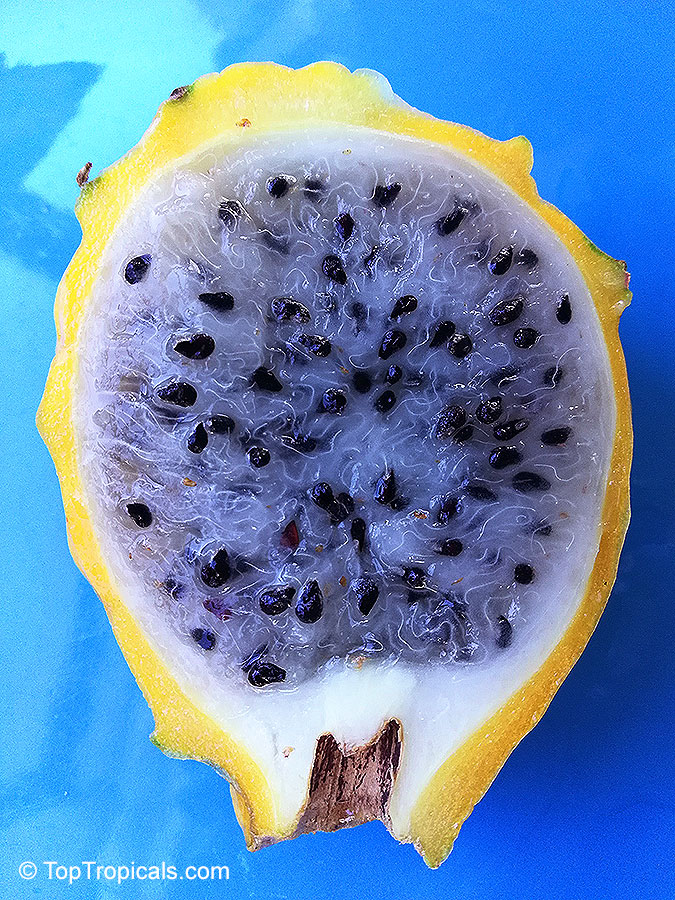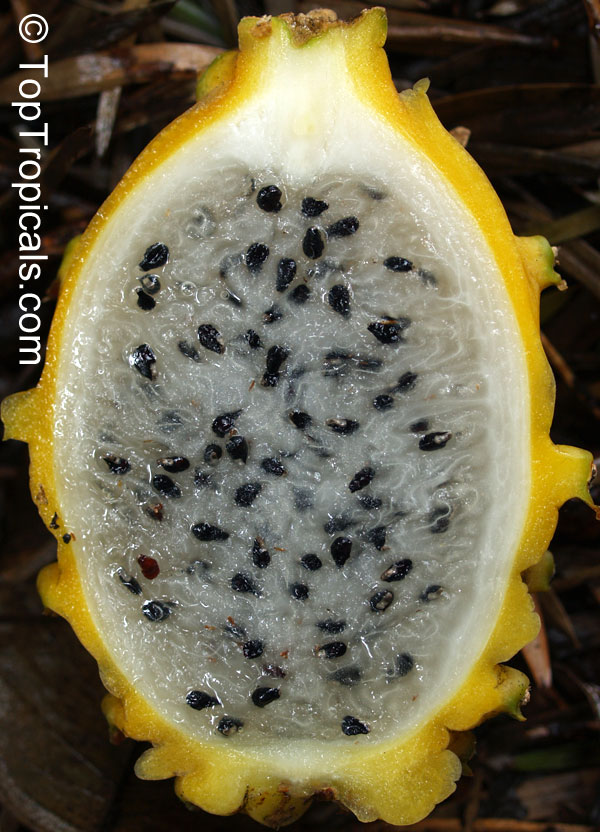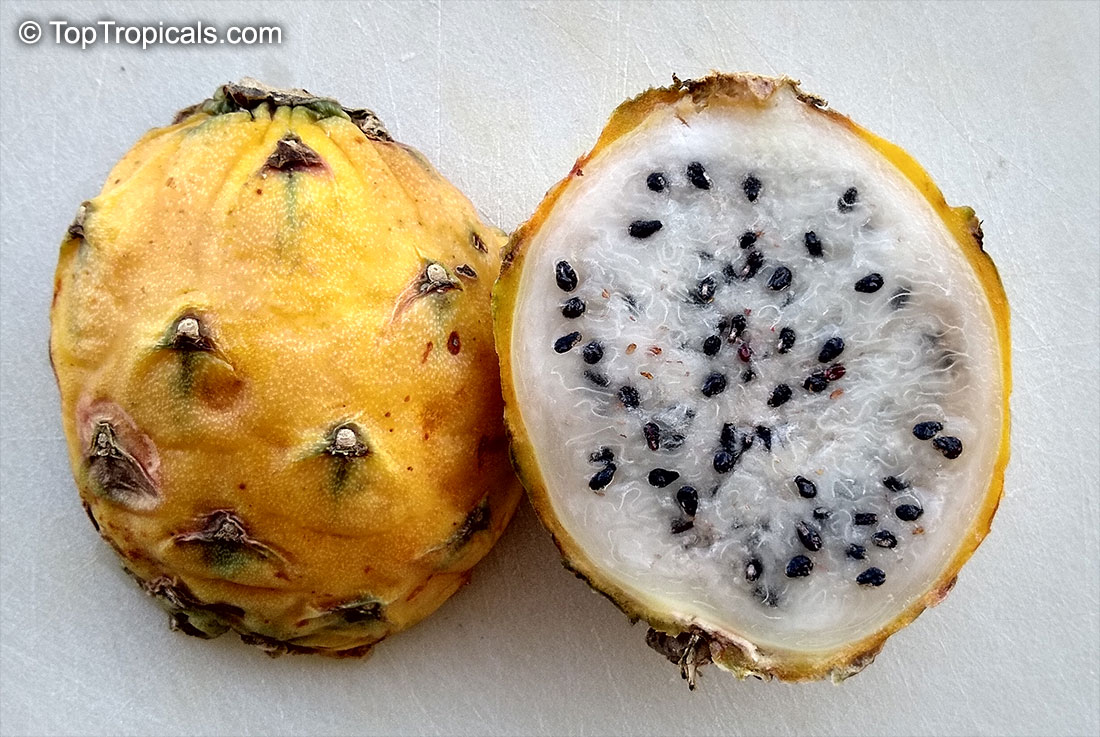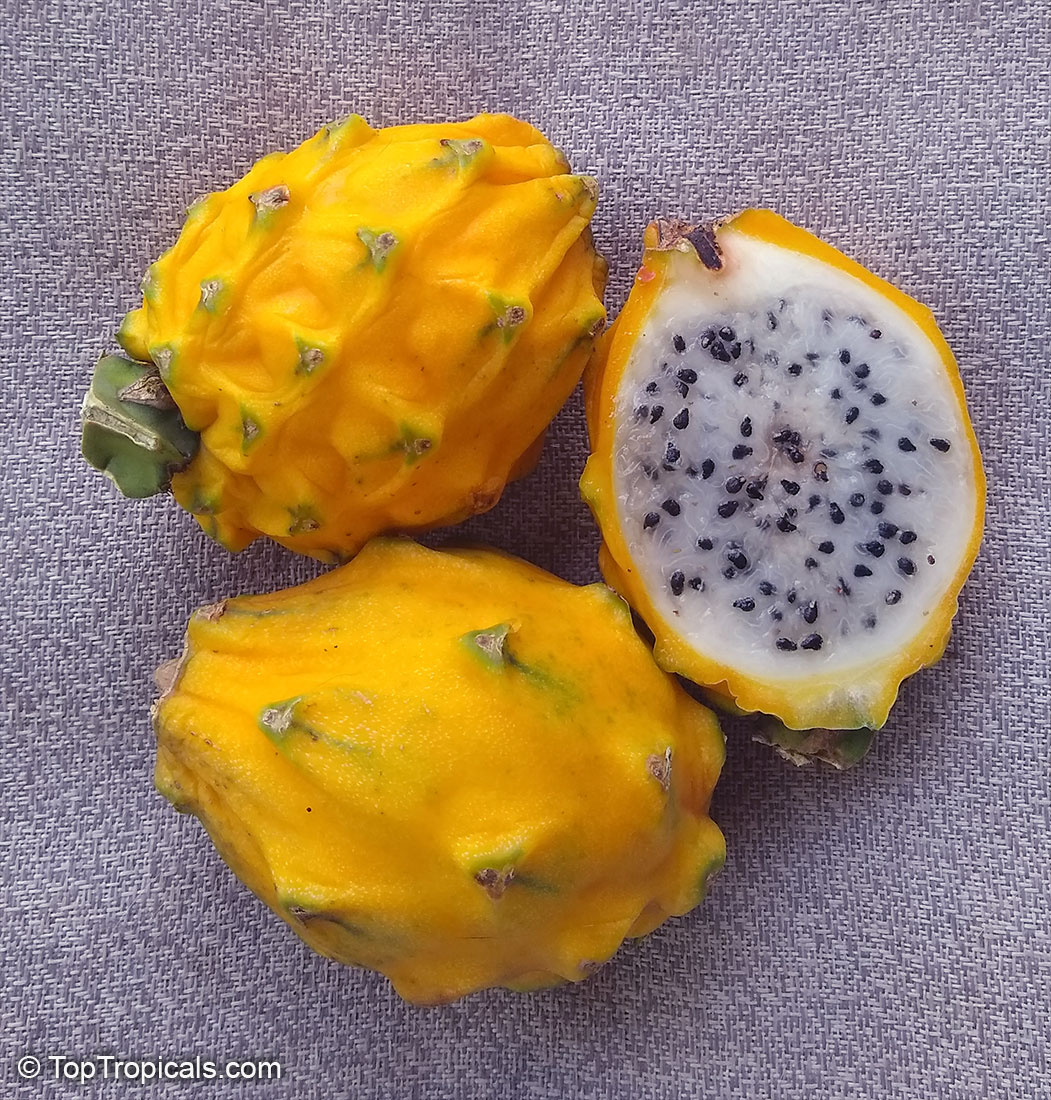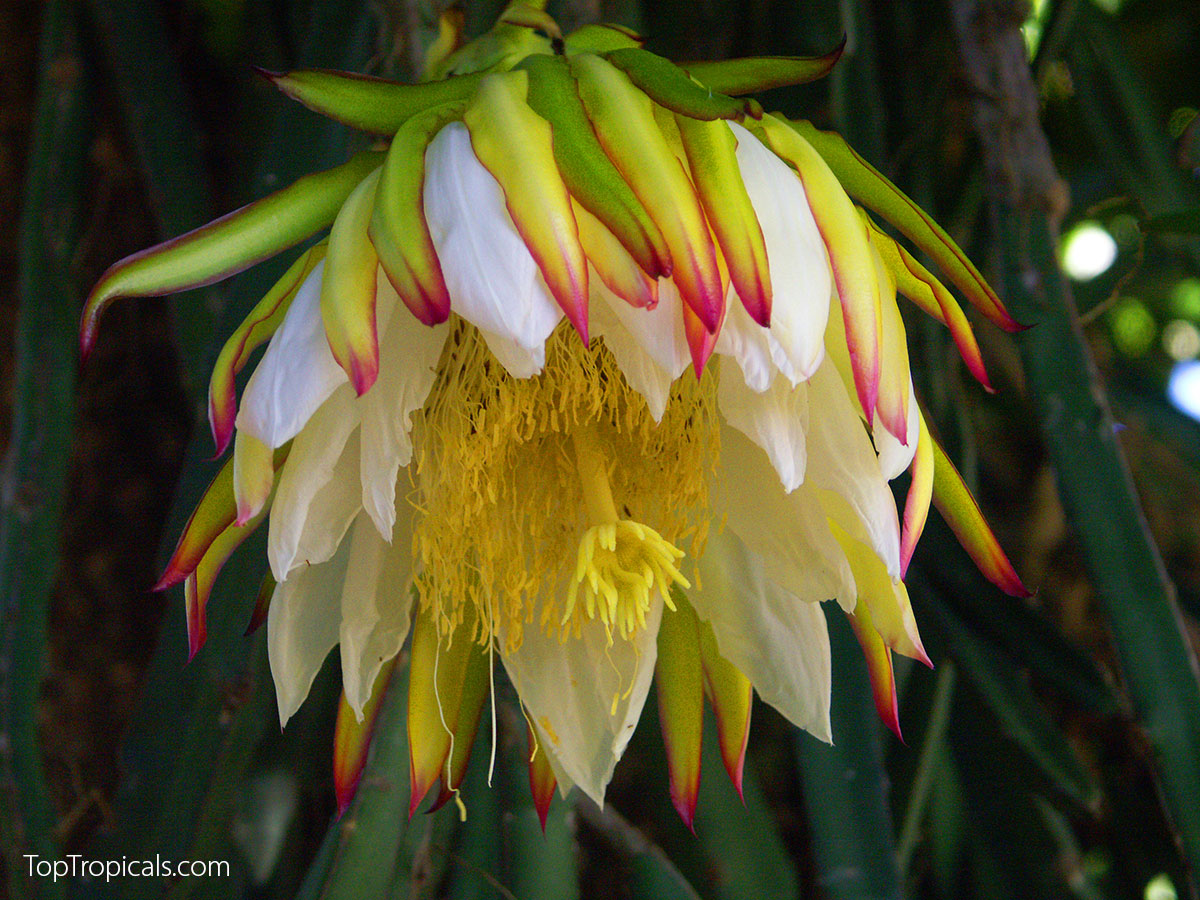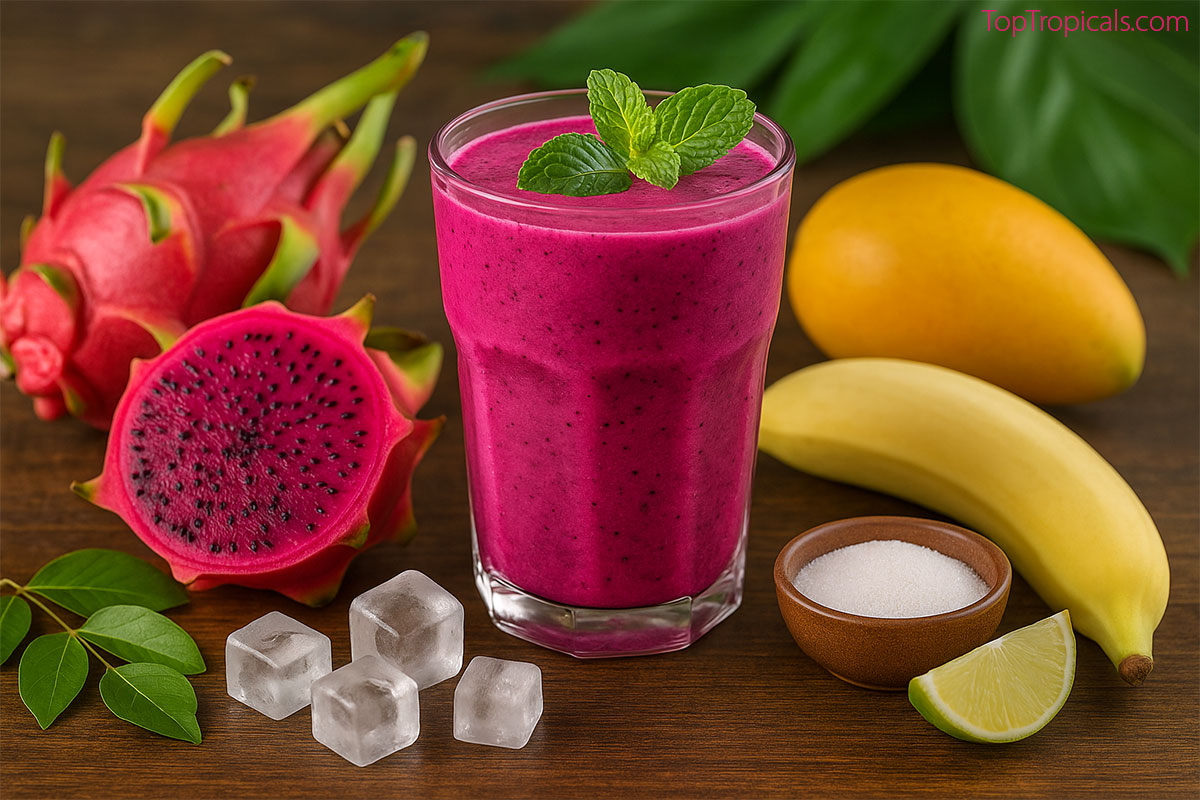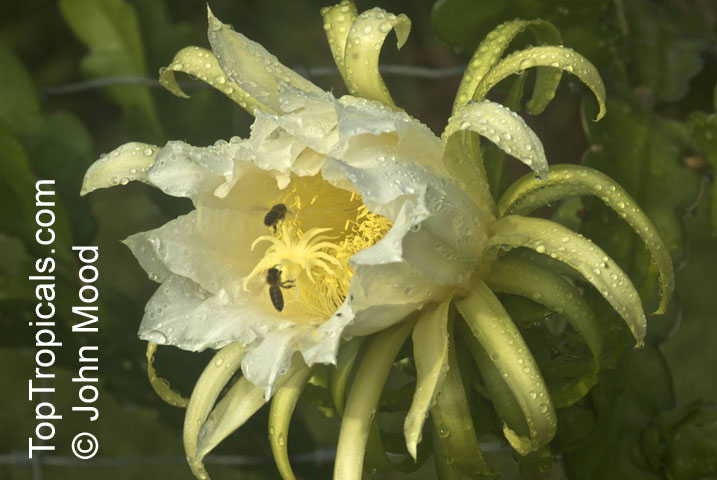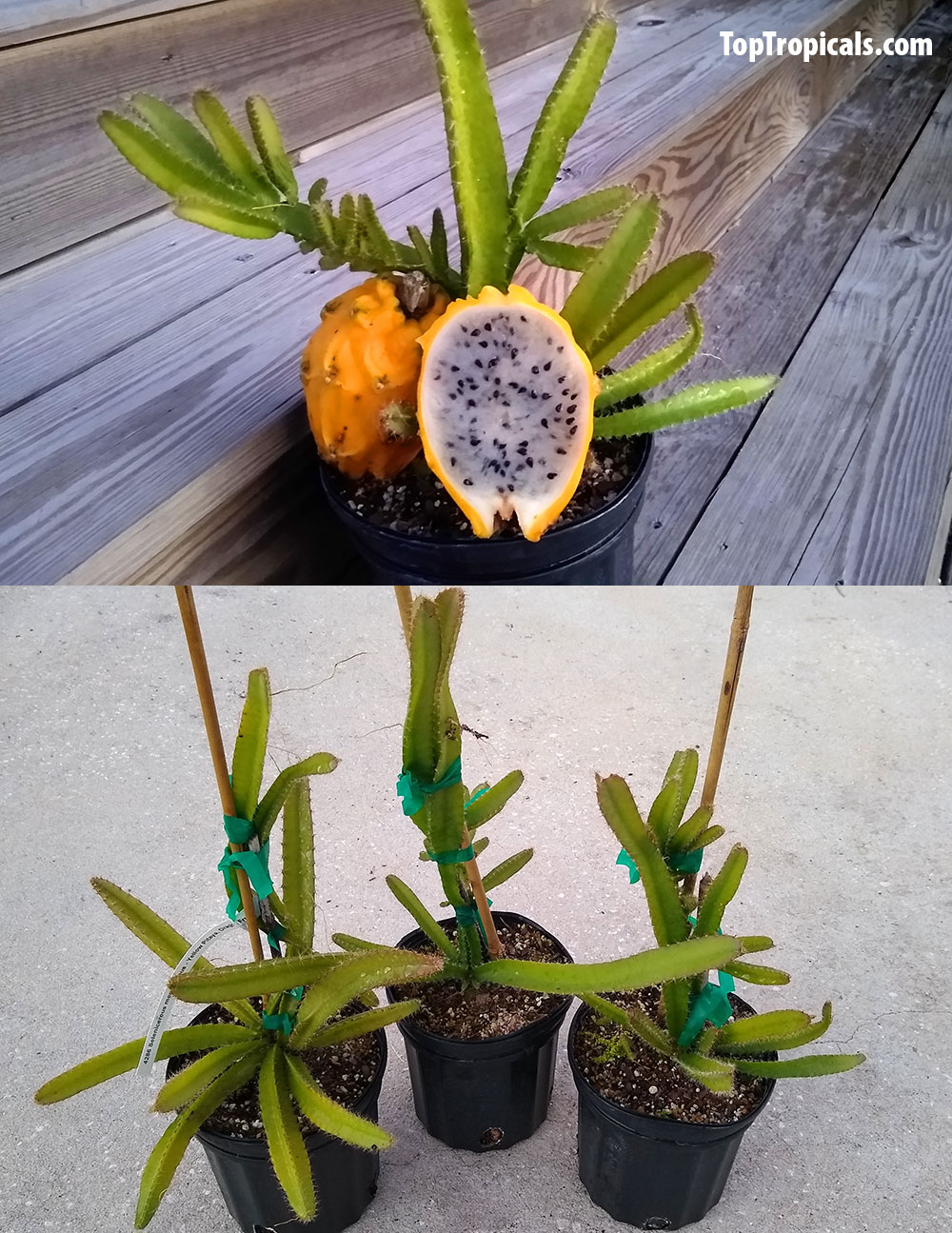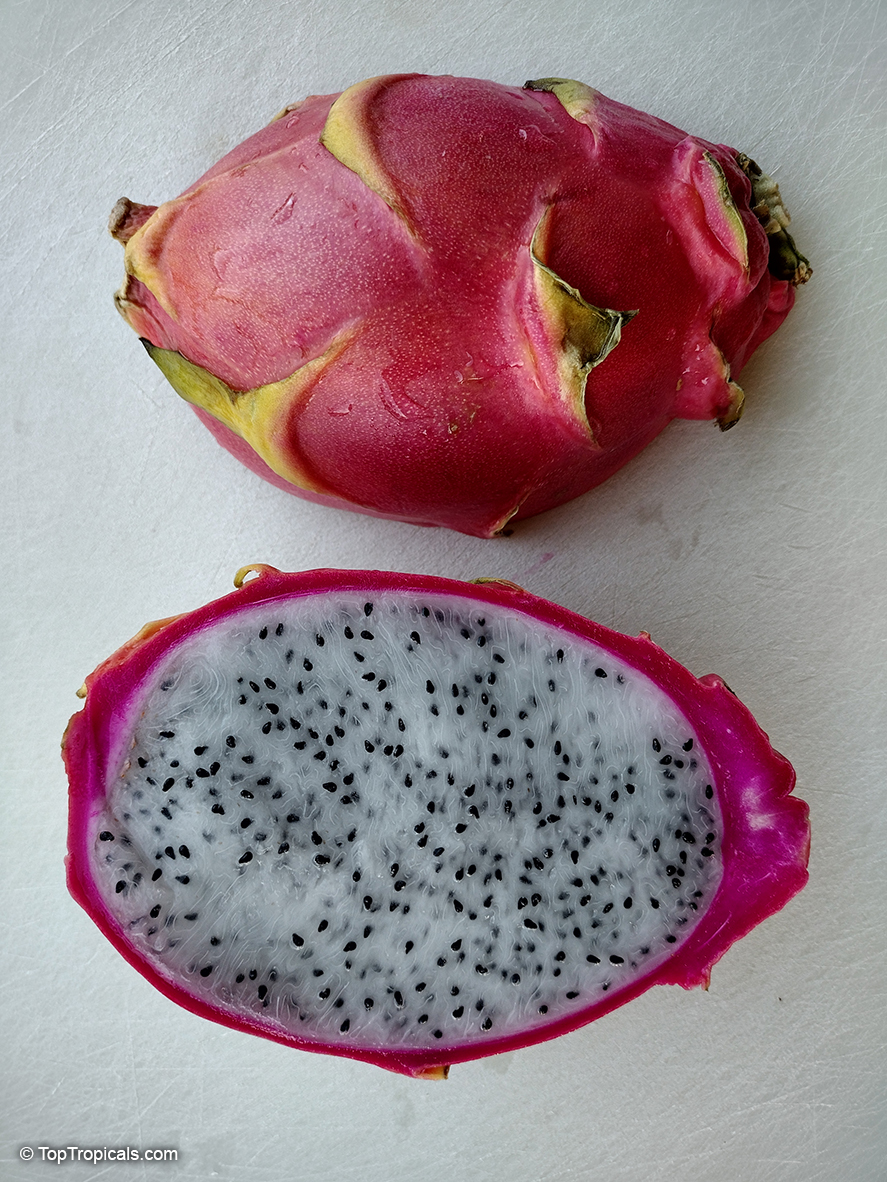










What does a dragon taste like? Does Dragon Fruit come from a monster cactus? Learn why you need to grow your own
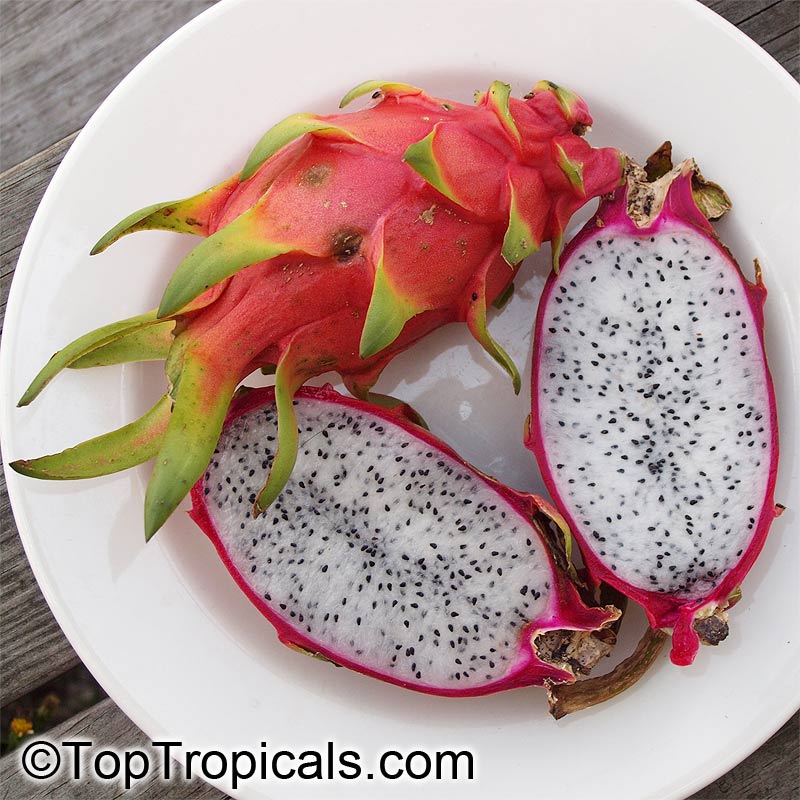
Hylocereus and Selenicereus Dragon Fruit or Pitaya
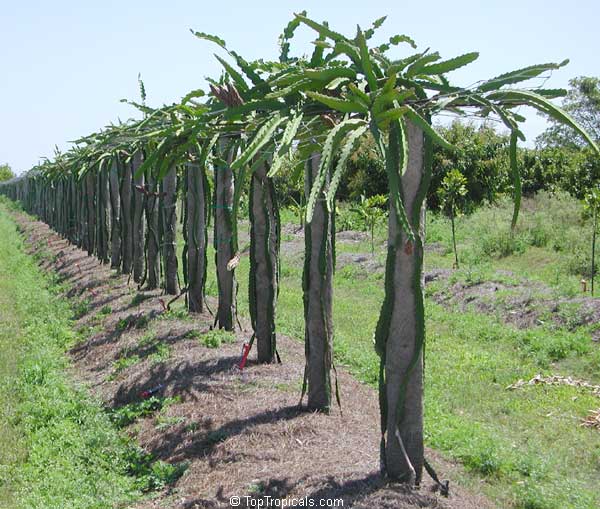
Hylocereus and Selenicereus Dragon Fruit or Pitaya trees on trellis
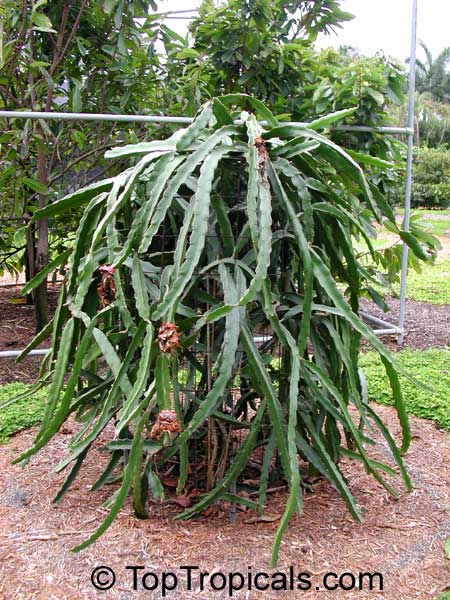
Hylocereus and Selenicereus Dragon Fruit or Pitaya on trellis
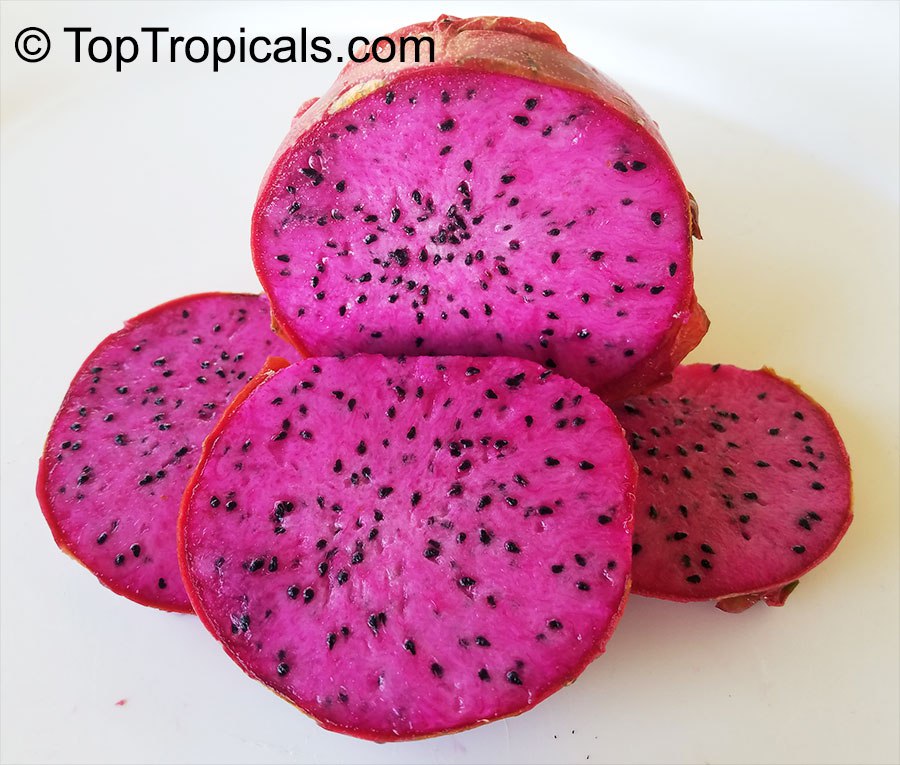
Hylocereus and Selenicereus Dragon Fruit or Pitaya red fruit
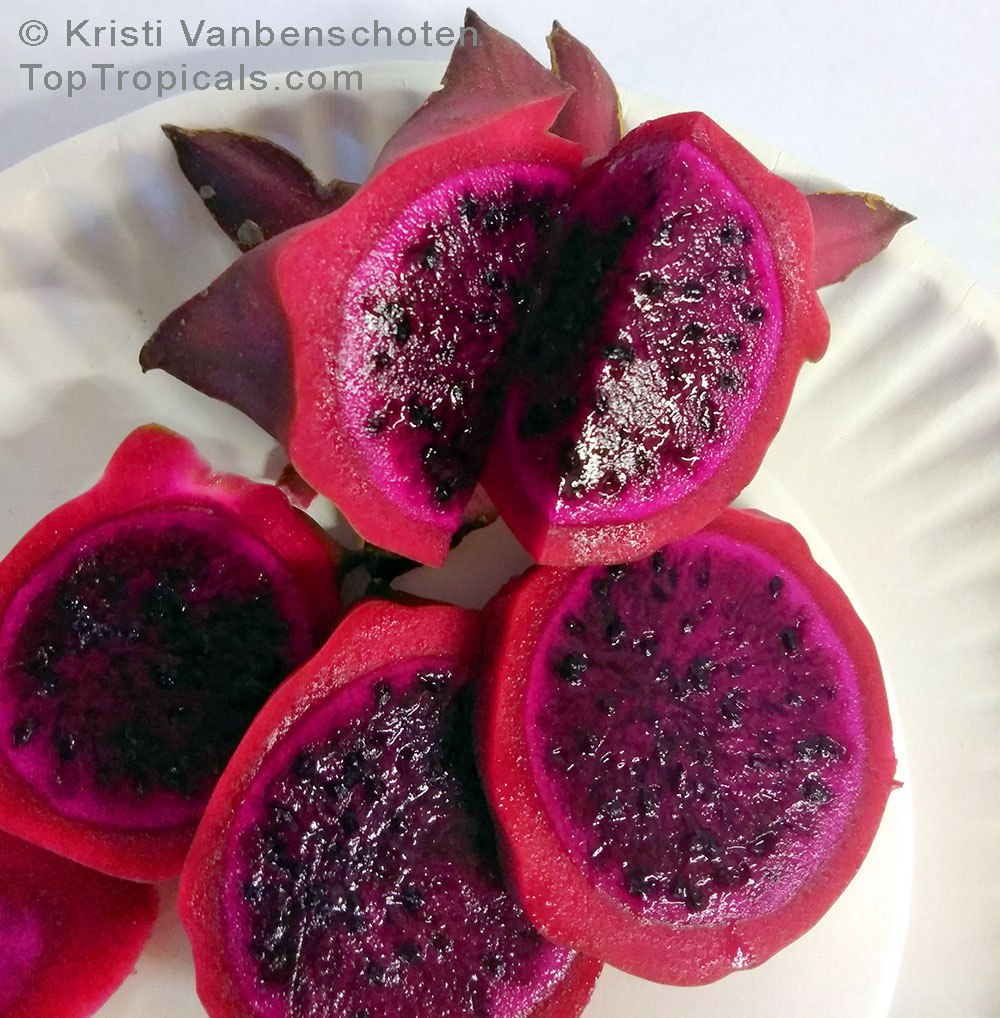
Hylocereus and Selenicereus Dragon Fruit or Pitaya purple fruit
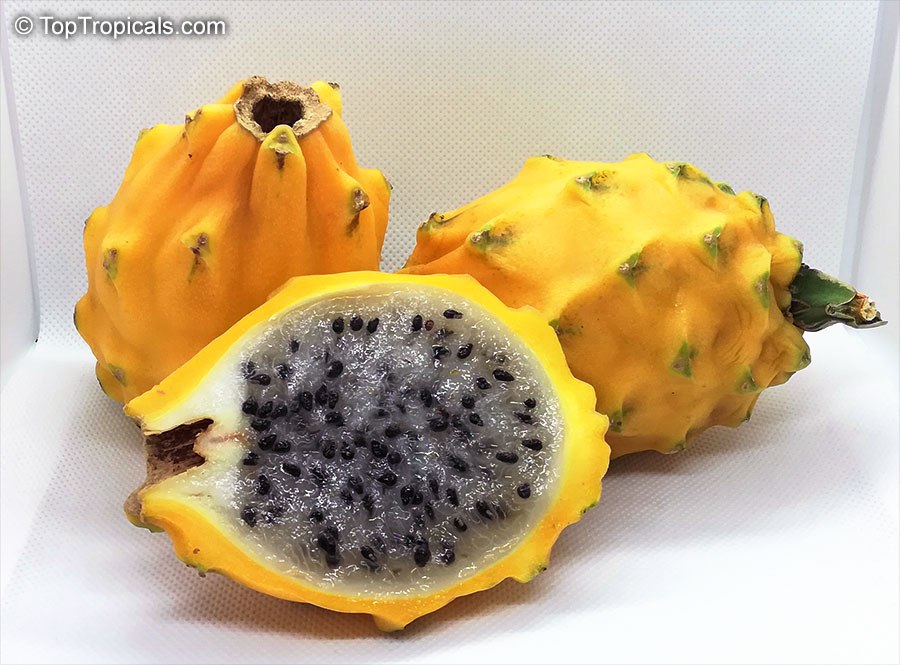
Hylocereus and Selenicereus Dragon Fruit or Pitaya Yellow Parlora
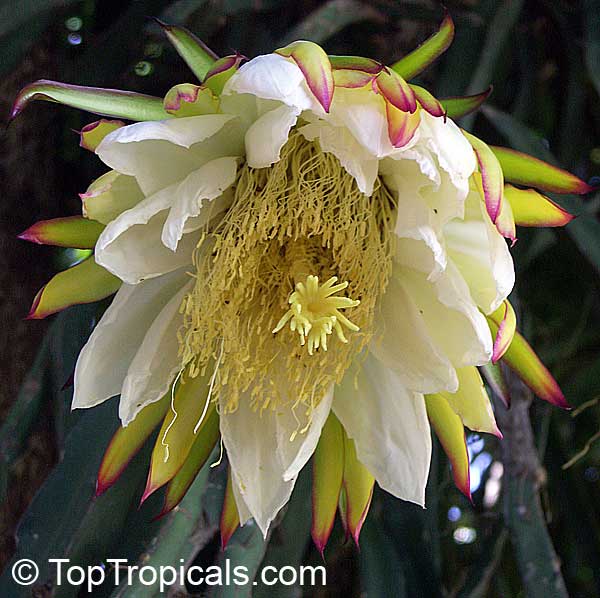
Hylocereus and Selenicereus Dragon Fruit or Pitaya flower
- 🔴 You may have tried a Dragon fruit from the store l, but do you know how it grows? On a cactus tree!
- 🔴 Names: varieties of Hylocereus and Selenicereus - these fruit bearing cactus plants are also called Dragon Fruit or Pitaya.
- 🔴 Commercially grown fruit sold in a grocery store may be tasteless. You need to grow your own good variety to have tasty, sweet, flavorful fruit!
- 🔴 Dragon fruit comes in many varieties. Colors of flesh differ: white, pink, dark red and even purple. The outside of the fruit can be red/pink or yellow.
- 🔴 In commercial groves, Pitayas grow like cactus trees, over a strong support - big "umbrella frames" ☂️
- 🔴 It is an easy plant, with low water needs, takes both sun and semi-shade.
- 🔴 Our favorite variety is Yellow Dragon Fruit Palora, (Selenicereus megalanthus). It is the sweetest and has the most flavor of all. We shared some recipes earlier.
- 🔴 Can be grown in container with a wooden trellis. And the flower is beautiful, too!
📚 Learn more about Dragon Fruit
🍹 Recipe: What to do with a Dragon fruit?
🛒Grow your own Tasty Dragon Fruits
#Food_Forest #Recipes #Nature_Wonders
🏵 TopTropicals
Date:
🐲 The taste you will never forget
If you only know dragon fruit from the grocery store, you probably think it looks pretty but tastes bland. That is because most commercial fruit is picked early, shipped far, and loses its sweetness. The truth? Homegrown dragon fruit is juicy, sweet, and full of flavor. The best of all is the yellow variety, Palora (Selenicereus megalanthus), a cactus fruit from Ecuador that bursts with tropical taste.
🌵 Pitaya or Dragon fruit – what is the difference?
Both names describe the same climbing cactus. In Latin America it is called Pitaya, while Asia and English speakers say Dragon fruit. There are three main kinds:
- Red skin, white flesh (Hylocereus undatus)
- Red skin, red flesh (Hylocereus costaricensis)
- Red skin, purple or pink flesh (Hylocereus x costaricensis hybrids)
- Yellow skin, white flesh (Selenicereus megalanthus)
Some hybrids give purple or magenta flesh. All are beautiful, all are easy to grow at home.
⚡️ Do red, white, and yellow taste different?
Yes. White types are mild and refreshing. Reds are sweeter and juicier. Yellows are the sweetest of all.
⚡️ Flowers from a fairy tale
Dragon fruit flowers are among the most spectacular in the plant world. They open at night, glowing under moonlight, with pale petals and a sweet fragrance. Each flower can be a foot wide. Seeing one bloom feels like stepping into another world.
⚡️ Top Dragon Fruit Health Benefits
- High in fiber for digestion and gut health
- Low in calories but full of vitamins
- Great for weight management
- Adds color and freshness to smoothies and salads
🍹 Dragon Fruit Smoothie recipe
Blend together:
- 2 dragon fruits, peeled
- 1/2 cup mango pulp
- 1 banana
- 1 cup milk of your choice
- 2 tbsp sugar
- 1/2 tsp lime juice
- Ice cubes to taste
Top with mint for a refreshing tropical treat.
Watch Dragon Fruit short videos:
💲 Special Offer – 25% off Dragon Fruit Pitaya Plants!
Get 25% OFF Pitaya plants with code
DRAGON2025
Min order $100. Excluding S/H, valid online only, cannot be combined with other offers.
Hurry, offer expires September 29, 2025!
Date:
New Video:
How to make a "Dragon Fruit" fruit?
Selenicereus megalanthus
Selenicereus megalanthus - Yellow Pitaya, Dragon Fruit, is the best tasting Dragon Fruit in the world that is not only sweet, it has a great flavor (unlike
most Pitayas that are pretty watery). This particular species of Dragon fruit doesn't mind regular water and rains but is also
drought-tolerant.
In this video you will find out how to grow this plant and how to make it fruit.
WATCH NEW VIDEO >>
Stay updated with TopTropicals Videos by subscribing to our channel at YouTube.com/TopTropicals and get our latest video news of what is fruiting and blooming!
Too weird to ignore, too easy not to grow!
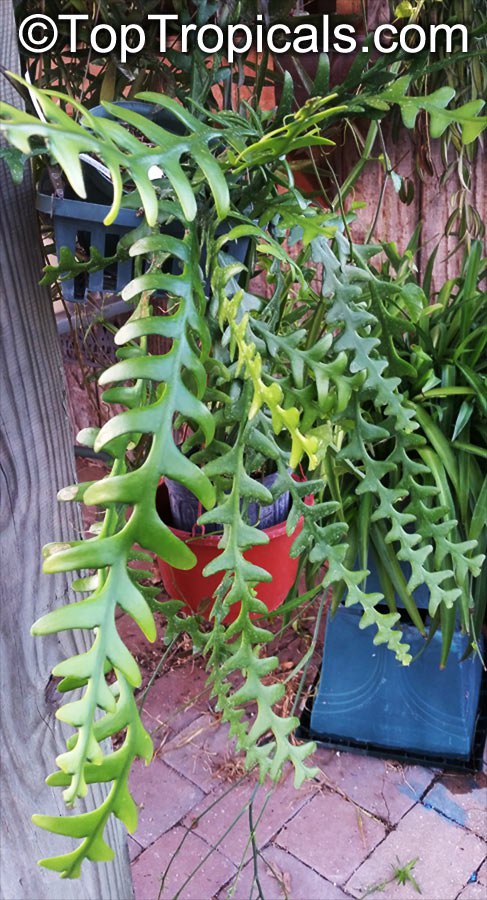
Cryptocereus (Selenicereus) anthonyanus - Zig-Zag Cactus, Anthony's Rick-Rack, Fishbone Cactus

Cryptocereus (Selenicereus) anthonyanus - Zig-Zag Cactus, Anthony's Rick-Rack, Fishbone Cactus, flower
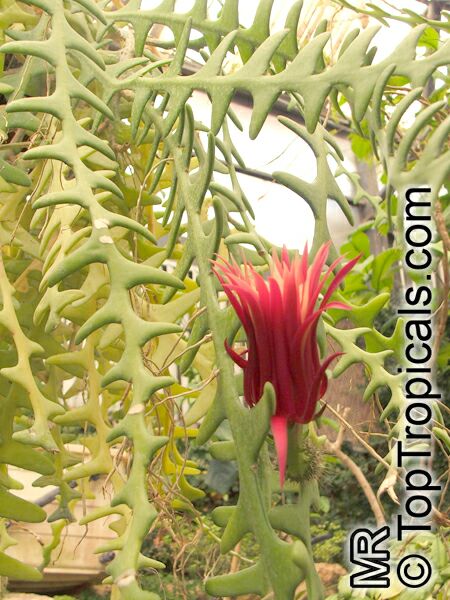
Cryptocereus (Selenicereus) anthonyanus - Zig-Zag Cactus, Anthony's Rick-Rack, Fishbone Cactus
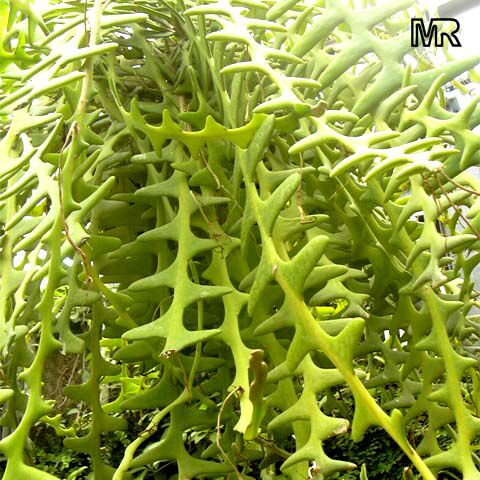
Cryptocereus (Selenicereus) anthonyanus - Zig-Zag Cactus, Anthony's Rick-Rack, Fishbone Cactus, leaves
- ⚡️Cryptocereus (Selenicereus) anthonyanus - Zig-Zag Cactus. Also known as Anthony's Rick-Rack or Fishbone Cactus, this oddball epiphyte is famous for its zigzagging, succulent leaves that look like a green lightning bolt.
- ⚡️ In nature, it climbs trees using aerial roots, but it's happy in a pot too.
- ⚡️Give it bright, indirect light and let the soil dry out completely between waterings.
- ⚡️In spring, it may reward you with a rare night-blooming flower that lasts just one magical evening.
- ⚡️ Easy, sculptural, and full of character!
🛒 Add this oddball to your jungle
📚 More about exotic epiphytic cacti:
Disocactus ackermanni - Red Orchid Cactus
Epiphyllum oxypetalum - Queen of the Night
Pseudorhipsalis (Wittia) amazonica - Blue Flame
Epiphyllum guatemalense Monstrosa - Orchid Cactus, Curly Locks
#Fun_Facts #Container_Garden #Shade_Garden #Nature_Wonders
🔴 Join 👉 TopTropicals
Selenicereus megalanthus
Family:Cactaceae
Pitaya, Pitahaya, Dragon Fruit, Strawberry Pear
Selenicereus megalanthus (Yellow Dragon Fruit), sometimes referred to as Hylocereus megalanthus, is a vigorous climbing cactus from the dry regions of South America, prized for its giant night-blooming flowers and sweet yellow fruit. Its long, three-ribbed stems need sturdy support and produce fragrant white blooms that open only for a single night, attracting nocturnal pollinators. The oval yellow-skinned fruit, easily cleaned of soft spines, holds juicy white pulp with a delicate floral sweetness. Although drought-tolerant at rest, the plant benefits from regular watering in hot weather to improve fruit size and flavor. Grow in full sun, in well-drained soil, and protect from frost. Lean more:
What to do with a Dragon fruit?
See detailed plant profile in new window: https://toptropicals.com/catalog/uid/selenicereus_megalanthus.htm
Hylocereus sp.
Family:Cactaceae
Pitaya, Pitahaya, Dragon Fruit, Strawberry Pear
There are three species of dragon fruit in the genus Hylocereus and one species in the genus Selenicereus. Varieties of Hylocereus guatemalensis, Hylocereus polyrhizus, and Hylocereus undatus as well as hybrids of these three species are grown commercially worldwide. Selenicereus megalanthus is grown commercially on smaller scales in South America and is especially popular in Columbia.
Related genera: Cereus, Acanthocereus, Echinocereus, Selenicereus, Stenocereus, Escontria, Myrthillocactus.
This climbing cactus is one of the most beautiful and wide spread members of the Cactaceae family. It is a highly prized, vining, fruit bearing cactus is terrestrial/epiphytic plant which is extremely unusual. It's fleshy stems reach up to 30ft. long, climbing onto walls or over trees using aerial roots. Magnificent flowers, stunningly beautiful fruit with an intense color, curious shape, and a delicious taste.
The night blooming white flowers can be up to 14 inches in length. Flowers are vibrant and beautiful and many related species are propagated as ornamentals. They generally bloom only at night, and usually last just one night where pollination is necessary to set fruit.
The fruit is most often eaten chilled and cut in half so the flesh may be spooned out. The juice is used in frozen drinks and it is in a new Tropicana Twister flavor. It is a must have for any collector or gardener with the flair for the unusual. The plants aren't usually too picky as to soil type, but because of their epiphytic nature, it is recommended to grow them in soil that is supplemented with high amounts of organic material. It can be grown successfully in sandy soils, providing shade is sometimes recommended in hot climates. In full production, these plants can have up to 4-6 fruiting cycles per year. Season: May-September.
The dragon fruit flesh can be white, red, or magenta. The red fleshed varieties contain lycopene which is a natural antioxidant known to fight cancer, heart disease, and lower blood pressure. Despite the health benefits and its spectacular appearance, the fruit has gone virtually unnoticed for centuries.
According to the legend the fruit was created thousands of years ago by fire breathing dragons. During a battle when the dragon would breathe fire the last thing to come out would be the fruit. After the dragon is slain the fruit is collected and presented to the Emperor as a coveted treasure and indication of victory. The soldiers would then butcher the dragon and eat the flesh. It was believed that those who feasted on the flesh would be endowed with the strength and ferocity of the dragon and that they too would be coveted by the Emperor. It is written that the dragons flame originates deep within its body near the base of its tail. The meat from this part of the dragon was the most desirable and most sought after portion. Only the officers of each division would be privy to this cut of meat. The ancient Chinese called this cut the jaina, which translates literally to the sweetest and best tasting. The jaina was treasured by all who were privileged enough to taste it, and it is believed that man's thirst for the jaina is what led to the destruction and eventual extinction of all of the dragons.
The mild and juicy fruit is easily cut in half and eaten with a spoon.
Today it is the leading fruit export of Vietnam. It has even caught the attention of Snapple, Tropicana, and Sobe which are just a few of the major labels that have incorporated dragon fruit into their bottled fruit drinks.
Lean more:
What to do with a Dragon fruit?
See detailed plant profile in new window: https://toptropicals.com/catalog/uid/hylocereus.htm
Detailed plant profiles: 2 plants found
